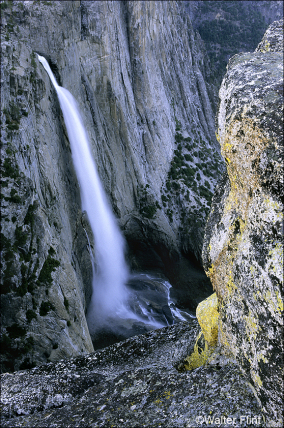Upper Yosemite Fall From the Forbidden Wall
During the first few years of the 21st century I would make an annual pilgrimage along the north rim of Yosemite Valley to visit the top of Ribbon Fall, Eagle Peak, and a special spot atop the “Forbidden Wall” overlooking Upper Yosemite Fall. I would time these trips to coincide with the peak runoff of the waterfalls which usually was in late May or early June depending on weather and the previous winter’s snowpack.
Getting to the top of the Forbidden wall involves a very steep uphill climb with no trail to make passage easy. Also, since there is no water at this place, my bottles must be filled in sufficient quantities to sustain me for the amount of time I am camping there.
One can see so many things from this unusual vantage point, but the best part of being there for me is the perspective of the Upper Yosemite Fall. This single aspect of Yosemite Falls is a little over 1,600 feet in length and by camping atop the Forbidden Wall I get to see it in its various incarnations of light throughout the day. In the early afternoon the refracted sunlight creates a beautiful rainbow in the body of the waterfall. In the early evening as the winds die down the amphitheater becomes a calm host for the waterfall and the mood scene goes from energetic to serene; frantically bright and sunshine imbued to calmly shaded, understated, and sublime.
There are SO many elements available to the photographer from this viewpoint that it is hard to decide where to begin. How does one begin codify so many elements into one meaningful vision that speaks not only to the photographer but any future viewer of the photograph? The giganticness of the various scenes facilitated the need for wide angle lenses and pushed the capability of my widest lens which was 20mm shooting on film.
As I searched at the edge of the cliffs that rise above the Upper Yosemite Falls trail I saw a small down-sloping ramp that led to a tiny wall of granite covered in mostly yellow, orange and blackish lichen. The down-sloping nature of the ramp portended that I use caution in approaching the rock with the lichen as I wished not to fall off the top of the Forbidden wall and land on some unsuspecting tourist hiking up the trail. This location is interesting and dangerous in that the trail traverses directly under this section of the cliff and anything falling from it would land directly on the trail. I used caution as to not knock any small pebbles onto the unsuspecting throng of hikers that make the journey to the top of the waterfall every single day in the summer.
The color of the lichen is what drew me into the scene and I wanted to find a way to combine the lichen and the waterfall. In that they are both vertically oriented entities it was compositionally challenging to find a way to make the scene work. There was a certain dead space in between the waterfall and the lichen rock that I needed to mitigate by moving the camera position to the right and merge my two subjects as much as possible, however, I felt that I needed to be able to see the bottom of the cliffs in a way that did not feel too truncated, and also to be able to see the rapids that formed at the bottom of the waterfall.
During the day, when the waterfall is in the sun, the energy and feeling that it projects is of a more frantic and vibrational energy. When the sun goes down in the afternoon and the fall is no longer in the sun, the feeling of it becomes more quiet, serene, and placid, and because of this I chose a one-second exposure to soften the water into a veil-like gossamer.
I actually got many photographs on this particular trip that still please me to this day but this photograph of the Upper Yosemite Fall is still the one of the ones that gives me the most satisfaction. There was calm in this scene that I felt acutely at the time I made the photo and this image is always reminding me of that sensory sensation.


